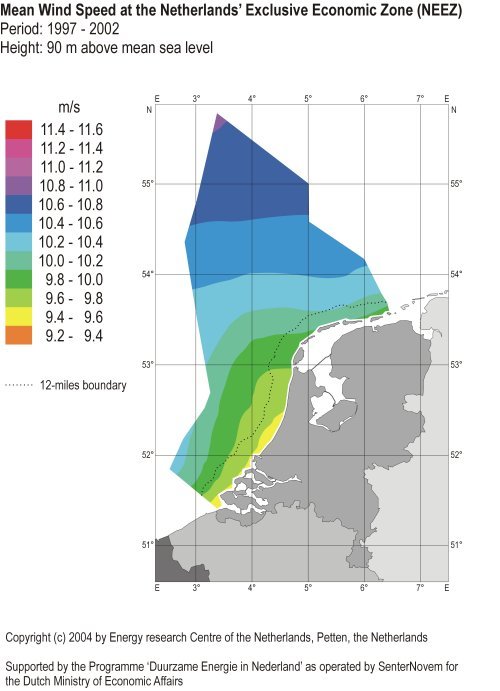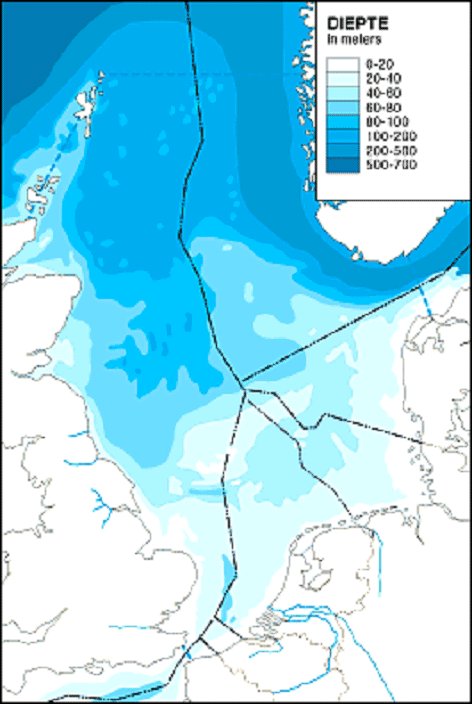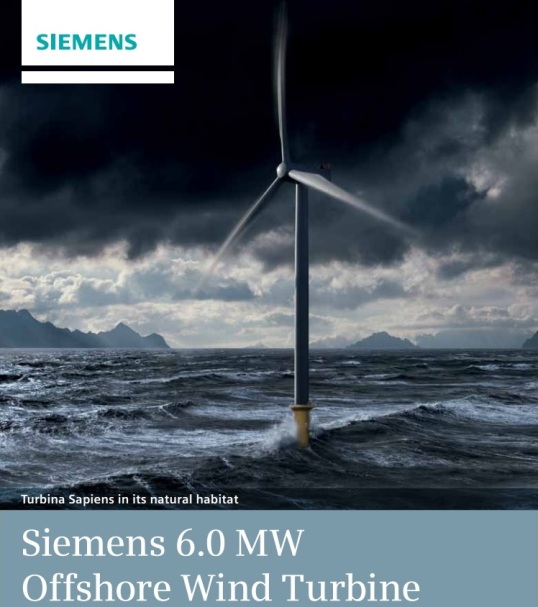Gold Mine North Sea
 [source] Partitioned North Sea
[source] Partitioned North Sea
A considerable part of Dutch wealth since 1960 was based on the natural gas field in Slochteren, once the #9 gas field in the world. That gas field is now running on empty. So what’s going to happen to the Cloggies and their wealth? Dire poverty? Not so fast.
Post-stamp country Holland measures 42k km2, think Kentucky. Its share of the North Sea however is larger: 57k km2… and has the potential to become the Dutch new energy province, replacing Slochteren and the coal mines of the Limburg province, closed down in the seventies.
Let’s make some simple back-of-the-envelope type of calculations to get an idea of the potential of this new energy province.
Let’s begin with a state-of-the-art wind turbine, the Siemens 6 MW SWT-6.0-154:
[energy.siemens.com] – Siemens Sapiens 6 MW offshore wind turbine
From the data sheet:
Swept rotor area: 18,600 m2
How much air flows through that area per second? Average wind speed North Sea is a breath-taking (pun intended) 9.5 m/s.
 [source]
[source]
That’s huge as you will soon see.
What is the mass of a “block” of air, measuring 18,600 m2 by 9.5 m? The density of air is 1.22 kg/m3. So the mass is 215574 kg or 216 ton. That’s more than 20 trucks of 10 ton each thrown at the rotor blades with 9.5 m/s speed, every second for 25 years (or more). The kinetic energy connected to that block of air is 0.5 x m x v^2 = 9727777 Joule or 9.7 MJ for every second or 9.7 MW. You always lose during the conversion from wind flow to rotor energy, take a factor of 0.59 (theoretical maximum, Betz law). 0.59 x 9.7 MW = 5.7 MW, slightly less than the nominal value of the SWT-6.0-154 (6 MW).
Now let’s convert this amount of energy into oil equivalent. A barrel of oil contains 1628 kWh. 6 MW during a day means 6 MW x 24 h = 144,000 kWh. That’s 144,000/1628 = 88 barrel/day. Or 32285 barrel/year or 0.80 million barrel throughout its 25 year life time (see pdf).
For a current oil price of $54 this would mean an equivalent of $43.3 million worth of oil during a 25 year calculated lifetime.
What is the price of the turbine?
[windpowermonthly.com] – Global costs analysis — the year offshore wind costs fell
[vanoord.com] – Van Oord betrokken bij Gemini offshore windpark
From the last link we see that the (realized) Gemini-project the cost tag was EUR 4.7 million/MW all in. The new Borssele tender sets new (lower) price records for offshore wind.
Take median value of $5 million / MW. That would be $30 million for our SWT-6.0-154. Add to this 20% maintenance cost and the total price tag for the turbine would be some 36 million euro.
How about the financial return on investment?
$36 million input and $43.3 million oil equivalent return in 25 years. That’s not bad.
What about the energy return?
0.80 million barrel for $36 million input, that’s $45/barrel.
But there is more. There is no reason to assume that after 25 years the wind tower will fall over and sink into the waves. Suppose the tower and monopile will last 50 instead of 25 years and that you only have to replace nacelle and rotor blades after 25 years for 15% of the total cost = $5 million, which would drive up the cost of the turbine to 36+5=$41 million for 50 years life-span. The oil price equivalent would be reduced to perhaps 26 dollar/barrel.
This $26/barrel equivalent makes sense only if you use the electricity from the wind turbine for heating purposes. In reality it needs to be said that electricity is a higher form of energy than heat from burning oil. The efficiency of conversion from electricity to motion energy in an eCar is ca. 60%. For a conventional car with combustion engine it is merely 20%. That’s a factor of 3 to the advantage of wind over oil (ignoring battery charge/discharge losses). So energy from wind-turbines for transportation would effectively reduce the “oil price” to merely $9/barrel.
This is the reason why you can say that the North Sea is a gold mine for energy production. According to Shell there is a potential for more than 50 GW until 2050. Currently (2013) total Dutch installed capacity: 31.5 GW. (20 GW in 1998)

The Dutch, Germans, British and Danes are relative the most lucky with shallow waters in their part of the North Sea. The Norwegians not so much. Floating turbines could be the solution for them.
